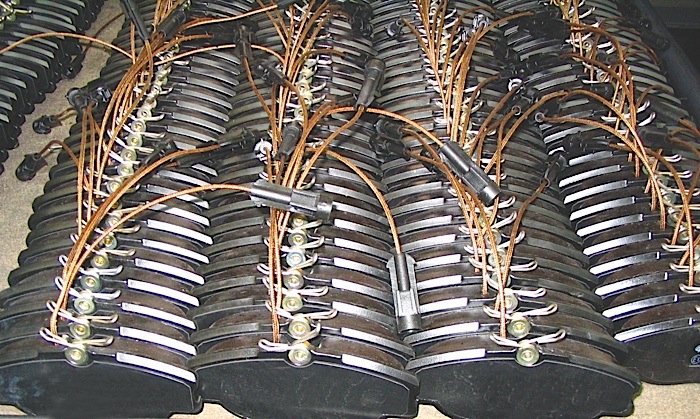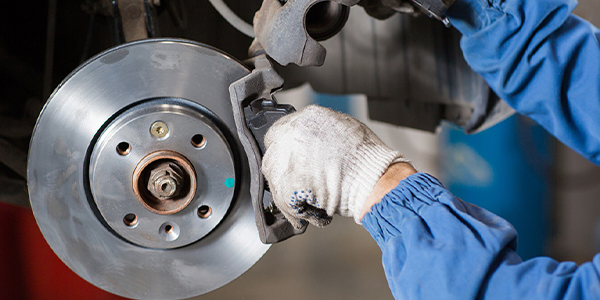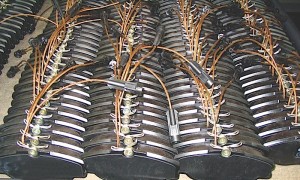 Friction is the force resisting the relative motion of elements sliding against each other. In the case of cars and trucks, it is the brake pads pushing against a rotor that changes kinetic energy into heat.
Friction is the force resisting the relative motion of elements sliding against each other. In the case of cars and trucks, it is the brake pads pushing against a rotor that changes kinetic energy into heat.
If you could mount a microscope on a brake pad, you would see bits and pieces of the pad and rotor breaking away from the surfaces as they contacted the rotor. As this is happening, the heat is physically and chemically changing the exposed friction material, and bits and pieces are being torn or sheared from the rotor and pad.
Some particles become part of the friction surface of the rotor, while others are cast off to stick to wheels and eventually be washed down the drain, potentially winding up in rivers and streams.
The bottom line is that for the brakes to function, the rotors and pads have to wear. Even a brake rotor’s metallurgy can determine how a pad wears.
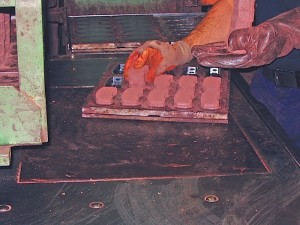 Two Types of Friction
Two Types of Friction
So friction is friction right? Wrong. There are two types of friction when it comes to brakes.
Abrasive friction is the breaking of bonds of both the pad material and the cast iron of the disc when the caliper pushes them together. Adherent (or adhesive) pad material forms a very thin transfer layer of pad material on the surface of the rotor. The two surfaces are the same materials and generate friction by breaking or shearing the bonds in the pad.
Abrasive friction is the wearing of the pad and rotor to change forward motion into heat. Both components wear. Semi-met pads and some non-asbestos organics (NAO) use this type of friction.
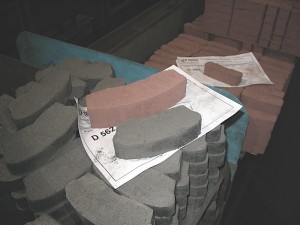 Adherent (or adhesive) pad material transfers a very thin layer of pad material onto the surface of the rotor. Ceramic and some NAO pads use this type of friction. The transfer layer is bonded to the rotor’s surface and cannot be washed away by water or wheel cleaners. The only way to remove it is by removing it with a brake lathe or abnormal heat.
Adherent (or adhesive) pad material transfers a very thin layer of pad material onto the surface of the rotor. Ceramic and some NAO pads use this type of friction. The transfer layer is bonded to the rotor’s surface and cannot be washed away by water or wheel cleaners. The only way to remove it is by removing it with a brake lathe or abnormal heat.
The layer is always being worn and replenished by the brake pad during braking. These pads produce dust. Adherent friction is easier on rotors, but the pads become the primary wear component.
With this type of pad, it is critical to machine the rotor with the correct surface finish and follow the recommended break-in procedure so the transfer layer can be established.
With both types of friction, it is critical for the rotor to have minimal runout. Abrasive friction materials will wear away at high spots, creating disc thickness variation and pulsation. Adhesive or adherent friction material could deposit the friction material unevenly and cause brake judder.
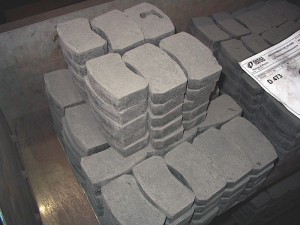 The Secret Sauce of Friction
The Secret Sauce of Friction
How the components in the friction material shear, break and interact during braking can determine a pad’s friction level, noise and wear characteristics.
A brake pad may require up to 20 different raw materials. Some raw components of a friction material are abrasive, while other components lubricate. Some components, like structural fibers and resins, hold the pad together, while other components tune the friction levels through various temperature ranges.
Tuning the components in a brake pad mix is like tuning a graphic equalizer on a stereo for the best sound. This is the secret art of friction material formulation and why some pad manufacturers protect their recipes like they’re Coke’s formula or KFC’s seven secret herbs and spices.
Ceramic
Ceramic pads’ structural properties are very stable under high temperatures, much like CorningWare cookware, but that is where the comparison ends. Ceramic materials that go into a brake pad are very small strands that are engineered to be a certain length and width.
There are three advantages of ceramic pads in certain applications. First, since the ceramic materials offer stable performance under a wide range of temperatures, they can offer quiet performance. Second, ceramic brake pads manage heat in the caliper better on some vehicles than some non-ceramic applications. Third, ceramic brake dust doesn’t show up on, or stick to, wheels like some other brake pad formulations. This could be an important factor if you have an expensive set of custom wheels.
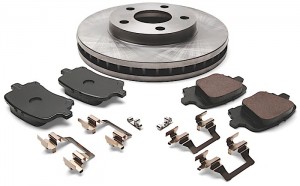 NAO
NAO
Non-asbestos organic (NAO) friction materials typically wear more than harder semi-metallic compounds. Generalizing about the wear characteristics of NAO and ceramic-based compounds is difficult because there are so many variations. Wear varies depending on the formula the friction supplier chooses for a particular application. Different vehicles require different coefficients of friction, so formulas are often “application engineered” to deliver the best combination of stopping power, wear resistance, pedal feel and noise control. Most premium-quality NAO and ceramic-based linings will provide long life and wear less than an equivalent set of NAO pads on the same application.
Semi-Metallic
Semi-metallic pads use metal fibers to give structure and provide friction. The metals used are typically high-quality steel, copper and other exotic metals.
The other part of the semi-metallic mix is comprised of a variety of materials like glues, lubricants and structural fibers. The manufacturer will blend the components together to give the best performance for that application.
Hybrids
Some friction manufacturers are picking and choosing the best properties of ceramic, NAO and semi-met to make hybrid brake pads that are quiet, but still have aggressive performance. Some of these pads are problem-solvers for known noise-prone vehicles.
A Word On Dust
Many ceramic brake pads claim to have “low dusting” formulation. But, how is this accomplished? The materials found in some ceramic brake pads are more compatible with today’s popular aluminum, open-wheel designs.
Also, some manufacturers have carefully chosen raw materials that are also used to help eliminate the appearance of dusting. The color of the material is a light gray, so it is less visible on wheels (unlike some NAO pad materials that produce a dark brown or black dust that clings to wheels).
Ceramic particles are less abrasive to the rotor surfaces. In addition, some ceramic pads tend to contact the rotor in a more adhesive fashion to slow the wheel, as compared to semi-metallic and other pads that are much more abrasive.
The abrasive action wears away at the rotor and creates rotor dust that can stick to the wheel. This approach can reduce rotor wear by as much as 80%, increasing rotor life by as much as 400% versus semi-metallic pads on the same application.
Every brake manufacturer uses its own ceramic-based or ceramic-enhanced compounds. The type of ceramics used, the particle size, distribution, hardness and other ingredients that go into a ceramic type of friction material can all vary, even from one vehicle application to another. So, ceramics should not be stereotyped or viewed as some type of generic product.

